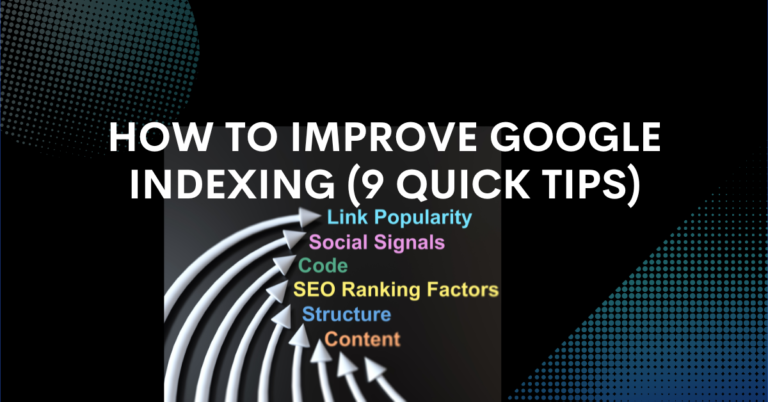|
Getting your Trinity Audio player ready...
|
Last updated on December 25th, 2024 at 02:12 pm
Thank you for reading this post, don't forget to subscribe!Your website will only appear on Google search results if it is indexed. That means it has become part of its inventory after crawling and analyzing i t. You need to improve Google indexing on your site to ensure search engines keep re-indexing it.
Why should you be concerned about search engines re-indexing your site? When search engine spiders crawl your website, they store that information and offer it to searchers. The same should happen when you add new information to keep your website appearing and ranking higher in search results.
Remember, the internet is vast and pumped with new content daily. You want to increase your chances of your website being found worthy.
How do you stay ahead of the crowd?
9 Pointers to Improve Google Indexing
An efficient index rate is what you need for your site. That means search engine spiders crawl and index any new content as soon as you put it up.
Read on to find out where to begin.
1. Set up Google Search Console to Track Crawl Status
If you have errors in your crawl status, it means your website has a deeper problem. Check every 30-60 days to ensure your other strategies aren’t wasted.
Be sure to set up your account using the same Google account you used for Google Analytics. Check under the index tab for your crawl status. Common errors include 404 errors, DNS errors, robots.txt errors, and server errors.
The sooner you fix any issues, the sooner crawling and indexing will happen.
Photo by Myriam Jessier on Unsplash
2. Submit a Sitemap to Every Search Engine
A sitemap tells search engines how the files on your website relate to each other, making it easier for them to crawl and index your site. It’s an XML list of every page on your site and will notify search engines of any changes.
All these aspects make it easier for search engines to crawl your site. That way, it ranks much faster on SERPs (search engine results pages).
You may want to consider doing this regularly if your site is busy. Automate it by installing a sitemaps plugin.
3. Clean up Your Content
Your content needs to be high quality. Focus on quality and a healthy sprinkling of the keyword. In the past, people added the keyword to a blog post as many times as possible with only slight variations to rank higher. This practice is now referred to as keyword stuffing and will get your site penalized.
Read through your site and eliminate any duplicate content. Large amounts of duplicate content will greatly slow your crawl rate.
4. Publish New Content Regularly
Publishing new content will alert search engines to crawl your site more often. It tells search engines that your site is constantly upgrading, so it needs to keep pace with crawling to reach its audience.
This is a great advantage for people who need to publish regularly. They’re assured of reaching their target audience.
Image by Steve Buissinne from Pixabay
5. Make Webpages Mobile-Friendly
Everyone has gone mobile. More people are accessing websites on their phones and tablets than on Pcs. Your best adaptation strategy is to make it easy for your audience. Make your website friendlier to mobile devices by implementing the following:
- Using responsive web design
- Optimizing images and videos
- Adding the viewpoint meta tag to the content
Test it on a mobile device to make sure the changes made a difference!
6. Structure Your Content
Order is essential for site indexation. Where you have related content, you can create relevant categories they can fit under.
It becomes easier to read through an orderly list of articles or blog posts under different categories than if the articles weren’t categorized and had unrelated content.
A logical sequence such as ‘Homepage>Category>Subpage’ is perfect.
Keep your URLs simple, clean, and optimized to improve Google indexing.
7. Optimize Media to Reduce Load Time
Page speed affects site ranking because Google gives importance to user experience. Photos and videos can be heavy and cause a bit of lag when loading a site. You should also think of it highly and adjust accordingly. How do you adjust?
Those images beautifying and adding flavor to your website need a little touch-up. Compress them without adversely affecting the image quality, and you’ll have a much lighter site.
Search engines are also likely to crawl the site more often when media is optimized since it takes less time and less of your crawl budget.
Photo by Monstera
8. Block Any Pages You Don’t Want Crawled
Are there particular pages you don’t want search engines to crawl? Consider blocking them by :
- Placing them in a robots.txt file.
- Placing a noindex tag.
- Deleting them.
That way, search engines won’t crawl them and won’t appear on search results.
9. Create a Content Marketing Strategy
For indexing to work, there must be content. And for content to work, it must be useful and targeted. How do you achieve this? With a content marketing strategy that works for your situation.
Think ahead and plan out a strategy using the following guidelines:
- Identify your goals and determine how you’ll measure progress.
- Determine your target audience in advance and map out their profiles. This will push your content in a direction that brings results and conversions.
- Determine the type of content that will impact your audience.
- Choose another suitable platform other than your website to share your content. It will increase your reach.
- Decide on a publishing schedule and stick to it. Consistency is key for your audience and site indexing.
- Look for tools and systems to make your work easier without compromising content quality. You may have to try a few before finding something that works for you, but the good thing is there’s lots of variety to choose from.
Photo by fauxels
Conclusion
You are better placed to improve Google indexing when you improve on and keep your website SEO up to date. A visit to Google Search Console will give you the right picture. Take advantage of the information and adjust accordingly.
Good luck!





